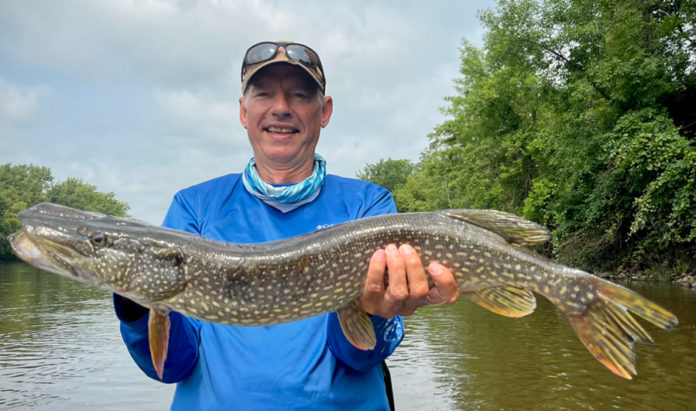Written by: Tom Werkman, Werkman Outfitters
Pike are the top predator in many river systems across the country, meaning they can afford to be picky about meals. Targeting pike on a fly rod can therefore be challenging–or even downright maddening depending on the day–but the difficulty makes success all the sweeter. Unlike other “fish of a thousand casts,” however, pike will readily eat flies under the right circumstances, which makes understanding their preferences crucial if you want to catch them consistently. Here are three less-intuitive tips I’ve picked up over the years:
1. Focus on the Slower Water
As ambush predators, pike often sit perfectly still in slack water that doesn’t typically appeal to other types of game fish, and might not be where you’re used to casting. Keep an eye out for areas of “frog water” with very slow-moving current and accumulated surface debris, particularly among structures such as submerged logs, weeds, or larger boulders that provide cover. We catch most of our pike in water that’s 3 to 10 feet deep and between 60-70 degrees.

2. Bigger Flies Aren’t Always Better
Given the northern pike’s fierce reputation and large size, many anglers gravitate toward big, flashy flies when targeting them, although bigger isn’t always better. Pike are clever fish, so the more big, gaudy flies they see, the quicker they learn to avoid them. We prefer relatively small and streamlined patterns such as the Fat Baby, Schultzy’s S3 Sculpin, Drunk & Disorderly and the Swinging D. For those rare-but-thrilling days when the pike are hitting on the surface, we mainly use Swim Frogs, which can draw some of the most explosive takes you’ll ever witness.

3. Mix up your Retrieve
Pike are fast swimmers, so it may be tempting to strip your fly at high speed in order to get their attention, but we have actually found that the opposite approach is best: a slower, more erratic retrieve with plenty of pauses between strips. Most times, pike will take the fly during the brief pause between strips as it hangs in the water column. They’re also infamous for following flies right up to the edge of the boat, so be sure to strip each cast all the way in until you can see the fly in the water and confirm there’s nothing behind it. Finally, if you miss a pike on the first cast or if it comes unhooked, sit and wait a couple of minutes and then try casting back into that same area. You’ll often get a second chance–sometimes even a third–before they finally get discouraged and move on.

Tom Werkman is owner and operator of Werkman Outfitters in Grand Rapids, Michigan.
Credit: Source link






























